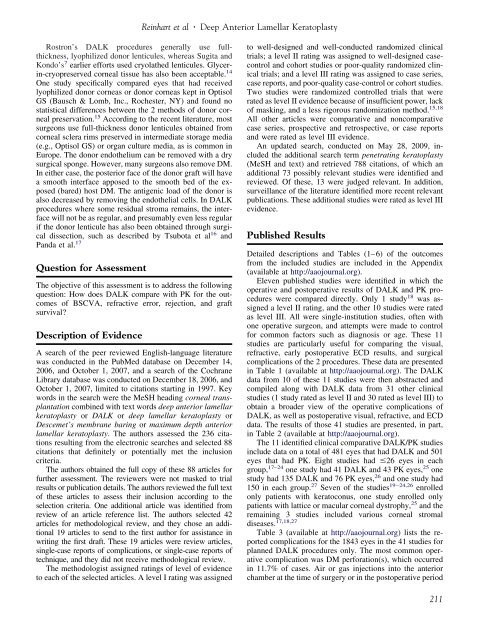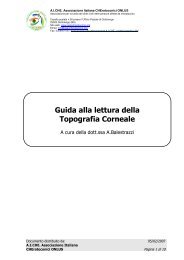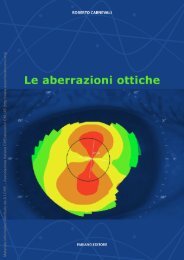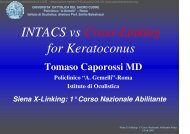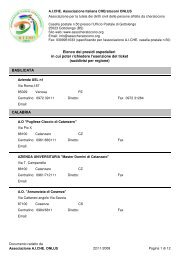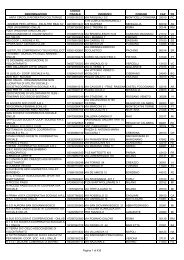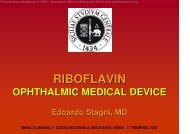Deep Anterior Lamellar Keratoplasty as an Alternative to Penetrating ...
Deep Anterior Lamellar Keratoplasty as an Alternative to Penetrating ...
Deep Anterior Lamellar Keratoplasty as an Alternative to Penetrating ...
You also want an ePaper? Increase the reach of your titles
YUMPU automatically turns print PDFs into web optimized ePapers that Google loves.
Reinhart et al <strong>Deep</strong> <strong>Anterior</strong> <strong>Lamellar</strong> <strong>Kera<strong>to</strong>pl<strong>as</strong>ty</strong>Rostron’s DALK procedures generally use fullthickness,lyophilized donor lenticules, where<strong>as</strong> Sugita <strong>an</strong>dKondo’s 7 earlier efforts used cryolathed lenticules. Glycerin-cryopreservedcorneal tissue h<strong>as</strong> also been acceptable. 14One study specifically compared eyes that had receivedlyophilized donor corne<strong>as</strong> or donor corne<strong>as</strong> kept in OptisolGS (Bausch & Lomb, Inc., Rochester, NY) <strong>an</strong>d found nostatistical differences between the 2 methods of donor cornealpreservation. 15 According <strong>to</strong> the recent literature, mostsurgeons use full-thickness donor lenticules obtained fromcorneal sclera rims preserved in intermediate s<strong>to</strong>rage media(e.g., Optisol GS) or org<strong>an</strong> culture media, <strong>as</strong> is common inEurope. The donor endothelium c<strong>an</strong> be removed with a drysurgical sponge. However, m<strong>an</strong>y surgeons also remove DM.In either c<strong>as</strong>e, the posterior face of the donor graft will havea smooth interface apposed <strong>to</strong> the smooth bed of the exposed(bared) host DM. The <strong>an</strong>tigenic load of the donor isalso decre<strong>as</strong>ed by removing the endothelial cells. In DALKprocedures where some residual stroma remains, the interfacewill not be <strong>as</strong> regular, <strong>an</strong>d presumably even less regularif the donor lenticule h<strong>as</strong> also been obtained through surgicaldissection, such <strong>as</strong> described by Tsubota et al 16 <strong>an</strong>dP<strong>an</strong>da et al. 17Question for AssessmentThe objective of this <strong>as</strong>sessment is <strong>to</strong> address the followingquestion: How does DALK compare with PK for the outcomesof BSCVA, refractive error, rejection, <strong>an</strong>d graftsurvival?Description of EvidenceA search of the peer reviewed English-l<strong>an</strong>guage literaturew<strong>as</strong> conducted in the PubMed datab<strong>as</strong>e on December 14,2006, <strong>an</strong>d Oc<strong>to</strong>ber 1, 2007, <strong>an</strong>d a search of the Cochr<strong>an</strong>eLibrary datab<strong>as</strong>e w<strong>as</strong> conducted on December 18, 2006, <strong>an</strong>dOc<strong>to</strong>ber 1, 2007, limited <strong>to</strong> citations starting in 1997. Keywords in the search were the MeSH heading corneal tr<strong>an</strong>spl<strong>an</strong>tationcombined with text words deep <strong>an</strong>terior lamellarkera<strong>to</strong>pl<strong>as</strong>ty or DALK or deep lamellar kera<strong>to</strong>pl<strong>as</strong>ty orDescemet’s membr<strong>an</strong>e baring or maximum depth <strong>an</strong>teriorlamellar kera<strong>to</strong>pl<strong>as</strong>ty. The authors <strong>as</strong>sessed the 236 citationsresulting from the electronic searches <strong>an</strong>d selected 88citations that definitely or potentially met the inclusioncriteria.The authors obtained the full copy of these 88 articles forfurther <strong>as</strong>sessment. The reviewers were not m<strong>as</strong>ked <strong>to</strong> trialresults or publication details. The authors reviewed the full tex<strong>to</strong>f these articles <strong>to</strong> <strong>as</strong>sess their inclusion according <strong>to</strong> theselection criteria. One additional article w<strong>as</strong> identified fromreview of <strong>an</strong> article reference list. The authors selected 42articles for methodological review, <strong>an</strong>d they chose <strong>an</strong> additional19 articles <strong>to</strong> send <strong>to</strong> the first author for <strong>as</strong>sist<strong>an</strong>ce inwriting the first draft. These 19 articles were review articles,single-c<strong>as</strong>e reports of complications, or single-c<strong>as</strong>e reports oftechnique, <strong>an</strong>d they did not receive methodological review.The methodologist <strong>as</strong>signed ratings of level of evidence<strong>to</strong> each of the selected articles. A level I rating w<strong>as</strong> <strong>as</strong>signed<strong>to</strong> well-designed <strong>an</strong>d well-conducted r<strong>an</strong>domized clinicaltrials; a level II rating w<strong>as</strong> <strong>as</strong>signed <strong>to</strong> well-designed c<strong>as</strong>econtrol<strong>an</strong>d cohort studies or poor-quality r<strong>an</strong>domized clinicaltrials; <strong>an</strong>d a level III rating w<strong>as</strong> <strong>as</strong>signed <strong>to</strong> c<strong>as</strong>e series,c<strong>as</strong>e reports, <strong>an</strong>d poor-quality c<strong>as</strong>e-control or cohort studies.Two studies were r<strong>an</strong>domized controlled trials that wererated <strong>as</strong> level II evidence because of insufficient power, lackof m<strong>as</strong>king, <strong>an</strong>d a less rigorous r<strong>an</strong>domization method. 15,18All other articles were comparative <strong>an</strong>d noncomparativec<strong>as</strong>e series, prospective <strong>an</strong>d retrospective, or c<strong>as</strong>e reports<strong>an</strong>d were rated <strong>as</strong> level III evidence.An updated search, conducted on May 28, 2009, includedthe additional search term penetrating kera<strong>to</strong>pl<strong>as</strong>ty(MeSH <strong>an</strong>d text) <strong>an</strong>d retrieved 788 citations, of which <strong>an</strong>additional 73 possibly relev<strong>an</strong>t studies were identified <strong>an</strong>dreviewed. Of these, 13 were judged relev<strong>an</strong>t. In addition,surveill<strong>an</strong>ce of the literature identified more recent relev<strong>an</strong>tpublications. These additional studies were rated <strong>as</strong> level IIIevidence.Published ResultsDetailed descriptions <strong>an</strong>d Tables (1–6) of the outcomesfrom the included studies are included in the Appendix(available at http://aaojournal.org).Eleven published studies were identified in which theoperative <strong>an</strong>d pos<strong>to</strong>perative results of DALK <strong>an</strong>d PK procedureswere compared directly. Only 1 study 18 w<strong>as</strong> <strong>as</strong>signeda level II rating, <strong>an</strong>d the other 10 studies were rated<strong>as</strong> level III. All were single-institution studies, often withone operative surgeon, <strong>an</strong>d attempts were made <strong>to</strong> controlfor common fac<strong>to</strong>rs such <strong>as</strong> diagnosis or age. These 11studies are particularly useful for comparing the visual,refractive, early pos<strong>to</strong>perative ECD results, <strong>an</strong>d surgicalcomplications of the 2 procedures. These data are presentedin Table 1 (available at http://aaojournal.org). The DALKdata from 10 of these 11 studies were then abstracted <strong>an</strong>dcompiled along with DALK data from 31 other clinicalstudies (1 study rated <strong>as</strong> level II <strong>an</strong>d 30 rated <strong>as</strong> level III) <strong>to</strong>obtain a broader view of the operative complications ofDALK, <strong>as</strong> well <strong>as</strong> pos<strong>to</strong>perative visual, refractive, <strong>an</strong>d ECDdata. The results of those 41 studies are presented, in part,in Table 2 (available at http://aaojournal.org).The 11 identified clinical comparative DALK/PK studiesinclude data on a <strong>to</strong>tal of 481 eyes that had DALK <strong>an</strong>d 501eyes that had PK. Eight studies had 26 eyes in eachgroup, 17–24 one study had 41 DALK <strong>an</strong>d 43 PK eyes, 25 onestudy had 135 DALK <strong>an</strong>d 76 PK eyes, 26 <strong>an</strong>d one study had150 in each group. 27 Seven of the studies 19–24,26 enrolledonly patients with kera<strong>to</strong>conus, one study enrolled onlypatients with lattice or macular corneal dystrophy, 25 <strong>an</strong>d theremaining 3 studies included various corneal stromaldise<strong>as</strong>es. 17,18,27Table 3 (available at http://aaojournal.org) lists the reportedcomplications for the 1843 eyes in the 41 studies forpl<strong>an</strong>ned DALK procedures only. The most common operativecomplication w<strong>as</strong> DM perforation(s), which occurredin 11.7% of c<strong>as</strong>es. Air or g<strong>as</strong> injections in<strong>to</strong> the <strong>an</strong>teriorchamber at the time of surgery or in the pos<strong>to</strong>perative period211


